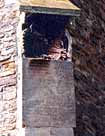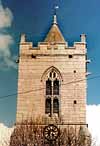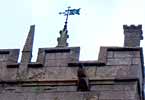For this church:    |
| ||||||||||||||||||||||||||||||||||||||||||||||||||||||||||||||||||||||||||||||||||||||||||||||||||||||||||||||||||||||||||||
| 1. | What number of persons receive communion? | |
 |
||
| 2. | What number of such persons are Popish Recusants or suspected for such? | |
 |
||
| 3. | What number of other dissenters (of what sort so ever) which either distinctly refuse, or, wholly absent themselves from the Communion? | |
Thomas Hall, the vicar, returned the following answers:-
Question 1: 102 persons
Question 2: None
Question 3: None
And one cannot help feeling that Thomas Hall had decided to keep a low profile!
One of Thomas Hall’s 102 parishioners was Robert Thoroton (1623-78), the Nottinghamshire antiquarian who lived in the village. His family donated what is called ‘The Restoration Plate’ to the Church in commemoration of the restoration of the monarchy and church in 1660.
 The Thoroton Tablet The Thoroton Tabletin the south-east buttress |
 Sketch of the Sketch of thetablet (1908) |
In 1664 Thoroton placed in the south-east buttress of the south aisle a stone slab to mark the burial place of some of his family. It bears a shield of four quarterings:
| 1 and 4 | Argent, a ... between three hunting horns sable [Thoroton] | ||
| 2 | Argent a lion rampant per fesse ... and sable [Lovetot] | ||
| 3 | Quarterly 1 and 4 per pale indented argent and azure, 2 and 3 argent a fleur de lys azure [Norin]. |
And the following inscription which is still reasonably legible:-
| Dec 12 1646 Regi & Ecclesiae fidus ROBERTUS Thoroton totius paterni coguominis penetusti jam superstitis parens & decus, ab antiquis hujus villae Dominis LOVETOTIS, scilicet, per MORINOS, Haereditarie genus & temim ducens, juxta ROBERTUM THOROTON patrem A 1604 peste mortuum MARIAM OUTRAM matrem & DOROTHEAM OLDNEY uxorum ejus hic infra sepultus fuit Anno aetatis suat 77. Cujus octo liberi, viz. I. ROBERTUS qui ex ANNA CHAMBERS conjuge providissima hic etiam A 1660 inhumata genuit ROBERTUM THOROTON M.D. virum ANNAE BOUN, MARIAM triennum filiolam A 1655 Submessum & hic Conditam, huc usque lugentis, Elizam, Rictum, Gervasium, Mariam & Thomam 2. Alicia 3. Richtus 4. Jolies, pater, Johannis, Robert, Rogeri, Francisca, Henrici, Mariae, Thomae, Willmi, Dorotheae, Annae 5 MARIA 6 THOMAS 7 DOROTHEA ET 8 FRANCA adhuc supersunt 1664. |
After the turbulence of the seventeenth century, the eighteenth was quiet and, as with many other churches during this period, the fabric of St Mary’s seems to have been neglected. The Archdeacon of Nottingham’s Court records show ‘presentments’ against the churchwardens on a number of occasions. In 1718, that ‘the Roofe of ye Chancell to be repaird by tiling and drawing ye walls within-side where it wants & whitewashing it all over within’.
Then four years later, in 1722, that ‘The out walls of church & chancel to be cleaned of weeds and trees, buttresses to be repointed, 3 locks on poor box and chancel roof repaired’. Again in 1729, that the Church to ‘provide a Table of Marriage, seats repaired where necessary especially by font, floor to be made even’, and then in 1735 that ‘the Lord’s Prayer and Creed to be set up in the Church and the pulpit repaired or a new one made’.
From the return of the Archbishop Herring Visitation of 1743 it appears the village was declining in size, as it records only 20 families, no dissenters and no meeting house.
Seven years later in 1750 the advowson was sold for £240 by Richard Porter of Arnold to the Reverend Henry Martin of Newark. He in turn, after 38 years, sold it to John Key of Upton in 1788 for £600.
As well as the advowson being sold twice, in the reign of George III the church was also transferred from the Hundred of Thurgarton to the Hundred of Bingham. Robert Lowe noted in 1794 that Car Colston was one of the parishes where enclosures had been made shortly before 1793 without the authority of Parliament.
Evidence that the decline of church and parish was still apparent in 1807, is shown when the vicar, William Kay, was given licence to reside away for two years because of his infirmity of body and his age, but also because the value of the living was small and the vicarage was unfit for his residence.
It would seem likely that with the advent of the nineteenth century St Mary’s was not in the best condition, although Stretton, writing in 1824, stated that the Creed, Lord’s Prayer, Commandments, and King’s Arms were modern. However, he also mentions that ‘a rich screen’ that separated the chancel from the nave had lately been taken down.
In 1838 the Old Vicarage was pulled down by the Reverend Girardon who built a larger one in ‘the Elizabethan style’. The population of the parish was also growing again in this period, and in 1841 there were 276 inhabitants.
By the 1851 Religious Census this had grown to 319 inhabitants; the census noting that the population consisted of 156 males and 163 females. The endowments of the church were part by land, part by tithe, amounting to about £150 p.a., and the spaces in the church were distributed as follows:
Free 150, other 134, total 284, with attendance as follows:
| General congregation | a.m. 60 | p.m. 70 | Even. 0 | |
| Sunday scholars | a.m. 50 | p.m. 50 | Even. 0 |
John Girardot - the vicar - added the following remark that the service alternated mornings and afternoons, and the average number attending was 60-70 besides the Sunday scholars.
Also recorded in the census are details of non-conformist growth in Car Colston. The Wesleyan Chapel was erected in 1835 and had fifty free spaces, 66 others and a general congregation of 70 in the evening. Later in 1848 the Independent Primitive Methodist Chapel was founded and this had 80 free spaces and 20 standing spaces. However, its general congregation was an average of 30 in the evening over a period of twelve months.
The first restoration programme of the nineteenth century was the renewal of the chancel roof in 1844. Two years later in 1846 the middle of the nave was cemented, but of the screen that Stretton mentioned in 1824, there was no recollection, although some broken tracery of a screen was found under a floor slab. One other event of this year was the erection of a school that was supported by voluntary contribution.
From 1844 a succession of restoration projects took place. In 1845 repair work was carried out to the chancel, and in the course of this Thoroton’s coffin came to light and became the cause of some ‘outrageous behaviour’. Of red Mansfield stone and measuring 7'3" long and 2'7" at its widest, it was found close to the surface and opened. The skeleton was thrown out and the skull put in the village shop as a curiosity! The following day the Reverend Girardot, having heard about this, ordered the remains be collected and replaced in the coffin which was then re-interred. Unfortunately, in 1863 this ‘outrage’ was repeated when work in the churchyard was being undertaken, but this time the empty coffin was placed in the church.
 The
top of the tower The
top of the tower |
 The weather vane The weather vane |
In 1857 further work was undertaken when it was decided to raise the height of the tower. At the same time a low octagonal roof of Ancaster stone was added, in an unusual form which is unlike any other found in the county. The weather vane is also quite unusual, being one of only three in Nottinghamshire that is not in a chanticleer form.
A major restoration was carried out in 1882 at a cost of £900. Part of this was the raising of the nave roof to its original pitch. Prior to this it was flat and covered with lead, but now it was tiled as well as raised. Extensive rebuilding of the aisles took place, and again, tiles replaced lead roofs.
The clerestory which previously had four windows - three square-headed with one light each, and a fourth easternmost window of three lights with semi-circular heads - was now rebuilt with three windows of two lights in the south wall.
 The
north doorway, The
north doorway,blocked up in 1882 |
The south porch walls were lowered and then partly rebuilt, and a high pitched tiled roof replaced the flat leaded one. Lastly, the small north doorway was walled up.
Internally, by this time, the Creed, Lord’s Prayer and orders that Stretton had mentioned, no longer existed.
In 1897 a county Antiquarian Association was started under the name of the Thoroton Society, and the first excursion of this Society was to Car Colston in July, when they inspected Thoroton’s coffin which was now inside the church.
It was decided in 1911 that further restoration work was needed on the tower and this was carried out at a cost of £250. The census of 1911 showed a population of 223 in the parish, made up of 52 households which had declined to 197 inhabitants in the 1931 census. This census fell within the incumbency of T E S Ferris who also held the living of Screveton. A motion that fusion with Screveton for church purposes should take place was petitioned against by 96 residents of Car Colston.
At the end of the south aisle can be found the Chapel of St John the Baptist. This was restored in 1984 in memory of Thomas Colston Blagg, of one of the notable families in the parish.
A restoration project took place over the years 2004-2011 which involved electrical re-wiring, replacing the glass in the east window and the easternmost window of the south chancel wall, the repair and re-tiling of the roofs, the installation of a new boiler, toilets and a kitchen in the former vestry and stonework re-pointed.
In 2008 the parish of Car Colston, along with Screveton and Flintham, were joined with East Bridgford and Kneeton under a single incumbent to make the Fosse Group of Parishes.
In November 2022 the bells were lowered and taken to John Taylor & Co. bell foundry in Loughborough for restoration. The bells returned in March 2023 having been restored for full-circle ringing and been augmented to six with two stock bells.
Relevant Dates
| C12 (?) | Building of church | |
 |
||
| 1349 | Appropriated to Worksop Priory | |
 |
||
| 1360 | Chancel rebuilt | |
 |
||
| C15 | Upper part of tower rebuilt | |
 |
||
| 1545 | Bellowe and Biggott given licence to alienate | |
 |
||
| 1570 | First register | |
 |
||
| 1616 | Gregory Henson bequeaths Sharpe Close to let for repair of leads and windows | |
 |
||
| 1623/78 | Robert Thoroton lived in village | |
 |
||
| 1842 | Thoroton's grave discovered | |
 |
||
| 1844 | Chancel roof renewed | |
 |
||
| 1863 | Churchyard lowered | |
 |
||
| 1882 | Restoration of nave, aisles and south porch roof. Thoroton's coffin placed in vestry. | |
 |
||
| 1901 | Altar of St John Baptist's chapel found | |
 |
||
| 1911 | Tower restored | |






